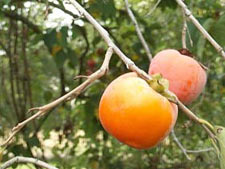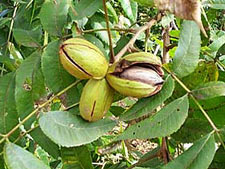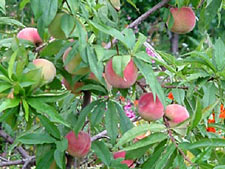
Persimmon trees produce gorgeous orange fruits that hang on the tree into fall and compliment the colorful fall foliage.

Nut trees such as pecans are long-term investments. They eventually become beautiful shade trees and the fruits provide food for wildlife and people.

Citrus trees come in many shapes and forms. Some are dwarf enough to grow in containers, making them easy to move indoors during winter in cold regions.

There is nothing like eating a tree-ripened peach. Pick when the background skin color turns from green to cream or yellow.
When selecting trees for your landscape, consider ones that will produce edible fruits and nuts. Fruit and nut trees are great because you don't need many of them (sometimes just one) to get an abundance of food. Some fruit and nut trees, such as persimmons, walnuts, pecans, and apples, can be grown for shade as well as fruit. Dwarf versions of these and other popular fruit and nut trees will even produce fruit when grown in a container.
Which Tree to Buy?
When selecting fruit or nut trees, consider ones that are adapted to your climate. Also, pick the right tree for the right location. Nut trees, such as walnuts and pecans, grow to 50 feet or more at maturity, while some crab apples may only reach 10 feet tall.Some types of fruit trees require at least two trees of different varieties in order to produce fruit. If you don't have room for two or more trees, consider self-fruiting varieties such as 'Northstar' cherry.
Also, don't limit your selection to the common fruits and nuts. There are many underutilized native and wild trees that make great edible landscape plants. Shadbush, dogwood, and pawpaw are native trees that are productive and easy to grow.
Finally, consider if the tree you're growing typically drops lots of fruits and nuts, creating a mess under the tree. Place these trees away from decks, patios, and sitting areas so you won't have any dropped fruits staining the wood or getting underfoot and attracting wasps and animals.
Planting Trees
Choose a site in full sun with well-drained soil. Dig a hole two to three times as wide as the rootball (or about 2 to 3 feet wide for bare-root trees). Plant at the same depth the tree was growing in the container. For bare-root trees, set the tree atop a small mound of soil in the center of the planting hole, and spread the roots down and away without unduly bending them. Identify the original planting depth by finding color change from dark to light as you move down the trunk toward the roots. If the tree is grafted, position the inside of the curve of the graft union away from the afternoon sun and a few inches above the soil line.For container trees, lift the plant out of the container prior to setting the rootball in the hole. Eliminate circling roots by laying the rootball on its side and cutting through the roots with shears. Don't cover the top of the rootball with backfill because it could prevent air and water from reaching the roots.
Fruit and Nut Tree List
Fruit and nut trees are usually available in various sizes, so look for the size that will work well in your space. For instance, dwarf apple trees grow 8 to 12 feet tall; semi-dwarf, 12 to 18 feet; and standard, 18 to 30 feet. Some dwarfs adapt very well to containers.- Apple: Small trees with beautiful white to pink spring flowers. There are many different varieties available that are adapted to varying climates. The flowers are edible, too, with a slightly sour taste.
- Banana: Tropical plant with evergreen foliage, sweet-smelling flowers, and edible fruit. Choose dwarf varieties, such as 'Dwarf Lady Finger', for containers. Bring indoors in winter in most locations.
- Apricot: Small to medium-sized tree with attractive white or pink spring flowers. Fruit matures in early to late summer.
- Cherry: Depending on the species, ranges in size from small shrubs to medium-sized trees. Some produce tart fruit good for pies, and others feature sweet fruit for fresh eating. All feature spectacular spring flowers. Fruit matures in summer to early fall, depending on the variety.
- Crab apple: Has a wider range of flower colors than apple trees. Look for varieties that feature large, tasty fruit that's good for jelly, such as 'Dolgo'.
- Citrus: Tropical fruits that are sensitive to cold weather. Some, such as 'Meyer' lemon, limes, and satsumas, can be grown in containers if you bring them inside for the winter.
- Fig: Small tree with interesting lobed leaves that reaches 10 to 30 feet tall. Fruit matures in midsummer to fall. Can be grown in containers.
- Kousa dogwood (Cornus kousa): Attractive tree that grows 20 to 30 feet tall. Showy white flowers are followed by tasty red fruits in mid- to late summer. Birds love these fruits as well.
- Loquat: Small evergreen tree with large glossy leaves, fragrant flowers, and fruit that matures in spring. Only hardy in USDA zone 9 and warmer locations.
- Pawpaw: Small native tree ranging from 12 to 20 feet. Fruit has a custard-like texture with a flavor resembling banana.
- Peach: Short-lived, small tree that reaches 15 to 20 feet tall. Beautiful spring flowers and summer fruit. Some good container varieties are available.
- Pecan: Large shade tree needing soil with excellent drainage. Nuts mature in late fall. The tree takes up to five years before it begins producing nuts.
- Pear: Medium to large tree with attractive spring blooms. Fruit matures during summer and fall.
- Persimmon: Small tree available in both native and Asian varieties. Some have very attractive foliage and good fall color. Fruits mature in fall.
- Plum: Small trees with attractive spring blooms. They fruit in midsummer, and even the blooms are edible.
- Quince: Shrub-like tree growing to 15 feet tall. Beautiful spring flowers. Fruit matures in fall and is good for jellies.
- Shadbush/Serviceberry (Amelanchier spp.): Shrubs or small trees with attractive, smooth, gray bark and abundant white spring flowers followed by red blueberry-like fruits. Spectacular reddish orange fall foliage. Better fruiting varieties, such as Amelanchier alnifolia 'Regent', are available.
- Walnut: Large shade tree that may take seven years after planting to produce nuts but will produce for up to 100 years. Roots emit a toxin that will inhibit some plants from growing close by. http://www.garden.org/ediblelandscaping/?page=edible-trees
No comments:
Post a Comment